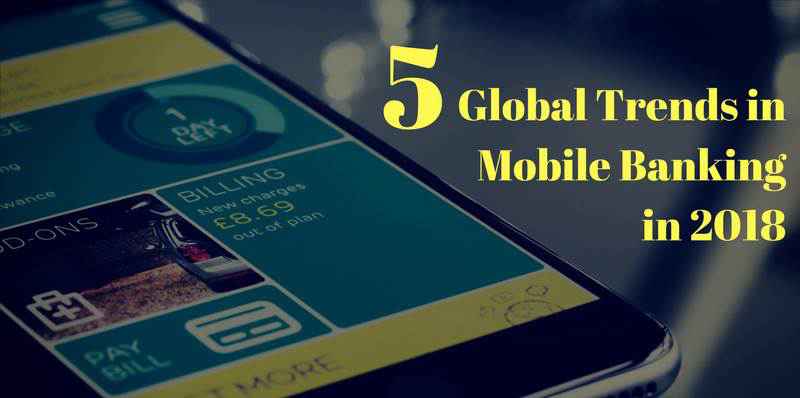The 5 Global Trends in Mobile Banking in 2018
Updated On : Apr 2018
With the global BFSI industry undergoing some landmark changes recently, smartphones, with the convenience of accessibility anytime, anywhere, have continued to grow as the preferred choice of banking. Today mobile banking has become one of the most important channels for banks to serve their customers better and also cut down on operational costs. Banks are developing their mobile initiatives and services to meet customer expectations and improve revenue growth strategies.
2018 has indeed started with more innovation to the mobile banking arena. Let’s look at 5 mobile banking trends this year:
The concept of Challenger banks
 Today banks are looking at more user friendly ways for financial advisors to interact with their customers than having them come to the branch. They are exploring the use of AI and chatbots which learn customer habits over time. This will enable banks to offer financial advice and services extensively.
Today banks are looking at more user friendly ways for financial advisors to interact with their customers than having them come to the branch. They are exploring the use of AI and chatbots which learn customer habits over time. This will enable banks to offer financial advice and services extensively.
AI and Chatbots advantage
 The messy web that records loans and securities costs investment banks billions of dollars to run. Today, this is managed through a myriad of messages and manual reconciliation One of the best-known examples of this restructuring is the Australian Securities Exchange, which aims to transfer a lot of its post-trade clearing and settlement on to a blockchain system
The messy web that records loans and securities costs investment banks billions of dollars to run. Today, this is managed through a myriad of messages and manual reconciliation One of the best-known examples of this restructuring is the Australian Securities Exchange, which aims to transfer a lot of its post-trade clearing and settlement on to a blockchain system
Bank of America’s launched their new chatbot "Erica" in 2017 to make it easier for customers who seek assistance in their financial decisions. Erica uses artificial intelligence and analytics (predictive) and cognitive messaging to help customers take care of several bank related jobs without having to go to a branch. Customers can make payments, check their balance, save money and also pay off debts. Customers can avail Erica through the bank’s mobile app and can use either voice or text to interact.
With the use of AI penetrating everywhere, banking emerges as an industry that has huge opportunities and will benefit highly from AI banking. Also, compared to a bank clerk, a bot has the potential to give much better and deeper insights into financial behaviour. Hence, banks moving towards this is one of the biggest trends predicted for 2018.
Internet of Things and voice payments
 Today everything from cars to smart home devices have a large number of voice control commands and it is predicted to increase even more. Many multinational companies like Mastercard, Samsung, Amazon and LG, have jointly developed new additions to their smart fridges with the existing infrastructure. These new additions will enable users to order and pay for their groceries using only their voice.
Today everything from cars to smart home devices have a large number of voice control commands and it is predicted to increase even more. Many multinational companies like Mastercard, Samsung, Amazon and LG, have jointly developed new additions to their smart fridges with the existing infrastructure. These new additions will enable users to order and pay for their groceries using only their voice.
Car makers too are getting into the act. Some like Daimler Financial Services, the financial arm of the group that owns Mercedes, has already announced the acquisition of PayCash as a part of the plan towards having Mercedes Pay, their own e-wallet. They see this as an important step towards expanding automobile services such as ride-sharing, car-sharing and all other car related payments.
The Blockchain technology
In 2017, when companies developed blockchain into applications in order to upset the mobile payments industry, it was seen that blockchain technologies can actually overcome a lot of challenges that mobile banking encounters. With the world moving towards less cash and becoming more card driven, electronic wallets are on the rise.
However with digital transactions, security has always remained the biggest concern. With Blockchain technology focussing on hyper security as its main priority, a lot of banking scams like fraud, double-spending and price gouging can be avoided. The Blockchain security
features like the multi signature verification will take care of frauds in these new systems and bring in trust.
Blockchains will also ensure fast and instant mobile payments. Along with the speed and security, the cost of transactions also minimises. With smartphones getting cheaper and user friendly, they are more accessible to the masses. Hence, it’s predicted that 2018 has huge opportunities in store for them.
Banking as a Service
The use of third party APIs is emerging as the future of banking even though it started slow in the banking sector. With the sharing of expertise by financial institutions, they become more flexible in the operations they offer. The German giant, SolarisBank who was granted a licence in 2016, gives its customers the liberty to choose their own banking modules and develops a customised banking experience for their customers.
Hence the new challenger banks, other fintech start-ups and banks pays exclusive attention to the customers and are able to customise and offer better mobile apps and more efficient ways for the customer to grow their money.
The Open Bank Project offers an app store of APIs from a strong bunch of partners and third party developers. The year 2018 is expected to see a keen interest in the project and towards open APIs in general.
Banking today is rapidly moving from buildings to smartphones. Admittedly, mobile banking is in its infancy stage but with more access to mobile services and dropping rates, the industry is looking at a radical change. There will be intensive innovations and the banking industry is looking at a revolution that will have no semblance of banking as we know it today.


Comments :